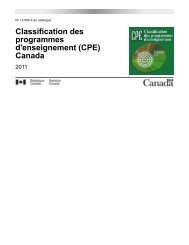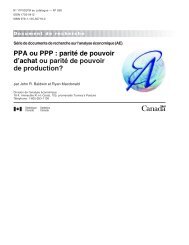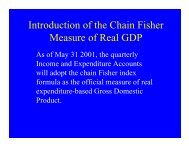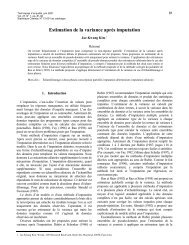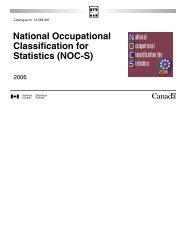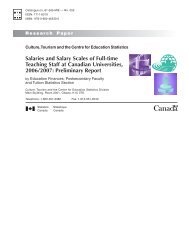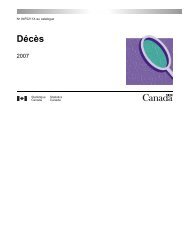Measuring the Economic Output of the Education Sector in the ...
Measuring the Economic Output of the Education Sector in the ...
Measuring the Economic Output of the Education Sector in the ...
Create successful ePaper yourself
Turn your PDF publications into a flip-book with our unique Google optimized e-Paper software.
aggregate enrolments between <strong>the</strong> two approaches. For <strong>the</strong> <strong>in</strong>come-based approach,<br />
enrolments are disaggregated by gender, education level (one <strong>of</strong> five levels), and age (age 6 to<br />
74). The five education levels are def<strong>in</strong>ed as: 0−8 years <strong>of</strong> school<strong>in</strong>g; some or completed high<br />
school; some or completed postsecondary school below bachelor’s degree; bachelor’s degree;<br />
and master’s degree or above. For <strong>the</strong> cost-based approach, enrolments are disaggregated by<br />
three education levels (primary and secondary, college, and university). This disaggregation is<br />
determ<strong>in</strong>ed by <strong>the</strong> availability <strong>of</strong> data on education expenditures.<br />
3. What are <strong>the</strong> estimates <strong>of</strong> <strong>the</strong> nom<strong>in</strong>al value <strong>of</strong> <strong>the</strong> output <strong>of</strong> <strong>the</strong> Canadian education sector<br />
from <strong>the</strong> two approaches?<br />
The nom<strong>in</strong>al value <strong>of</strong> education output from <strong>the</strong> <strong>in</strong>come-based approach is set equal to <strong>the</strong><br />
value <strong>of</strong> education as measured by its effect on students’ lifetime <strong>in</strong>come. The nom<strong>in</strong>al value <strong>of</strong><br />
education output from <strong>the</strong> cost-based approach is derived from total education expenditures,<br />
which <strong>in</strong>clude <strong>the</strong> labour costs <strong>of</strong> teachers and adm<strong>in</strong>istrative staff, capital costs, and<br />
<strong>in</strong>termediate <strong>in</strong>puts.<br />
The <strong>in</strong>come-based estimate <strong>of</strong> <strong>the</strong> nom<strong>in</strong>al value <strong>of</strong> education services is found to be much<br />
higher than <strong>the</strong> cost-based estimate. In 2005, <strong>the</strong> <strong>in</strong>come-based measure was estimated at<br />
about 6.8 times as large as <strong>the</strong> cost-based estimate.<br />
There are a number <strong>of</strong> potential explanations for this difference. First, <strong>the</strong> coverage <strong>of</strong> <strong>the</strong><br />
education sector differs between <strong>the</strong> two approaches. The education services sector <strong>in</strong> <strong>the</strong><br />
<strong>in</strong>come-based approach <strong>in</strong>cludes <strong>the</strong> <strong>in</strong>puts <strong>of</strong> non-market activities (<strong>the</strong> opportunity cost <strong>of</strong><br />
students’ time), while <strong>the</strong> cost-based approach does not. Second, <strong>the</strong> <strong>in</strong>come-based approach<br />
attributes <strong>the</strong> earn<strong>in</strong>gs differentials among <strong>in</strong>dividuals to <strong>the</strong> effect <strong>of</strong> <strong>in</strong>vestment <strong>in</strong> formal<br />
education (Rosen 1989). To <strong>the</strong> extent that <strong>the</strong> earn<strong>in</strong>g differential also captures <strong>the</strong> effect <strong>of</strong><br />
on-<strong>the</strong>-job tra<strong>in</strong><strong>in</strong>g, gender discrim<strong>in</strong>ation, and <strong>in</strong>dividuals’ ability, <strong>the</strong> <strong>in</strong>come-based approach<br />
overestimates <strong>the</strong> level <strong>of</strong> education output.<br />
Despite <strong>the</strong>se differences, <strong>the</strong> two estimates generate quite similar rates <strong>of</strong> growth <strong>of</strong> real or<br />
volume measures.<br />
4. What are <strong>the</strong> ma<strong>in</strong> challenges for measur<strong>in</strong>g <strong>the</strong> output and <strong>the</strong> productivity performance <strong>of</strong><br />
<strong>the</strong> education sector?<br />
The measures <strong>of</strong> <strong>the</strong> output <strong>of</strong> <strong>the</strong> education sector developed <strong>in</strong> this paper represent an<br />
important first step towards understand<strong>in</strong>g <strong>the</strong> productivity performance <strong>of</strong> <strong>the</strong> education sector.<br />
However, significant challenges rema<strong>in</strong>. Chief among <strong>the</strong>m are <strong>the</strong> changes <strong>in</strong> education quality<br />
that must be taken <strong>in</strong>to account <strong>in</strong> order to accurately estimate <strong>the</strong> productivity performance <strong>of</strong><br />
<strong>the</strong> education sector. While <strong>the</strong> hedonic method can be applied <strong>in</strong> order to take <strong>in</strong>to account <strong>the</strong><br />
quality changes <strong>in</strong> education output as shown <strong>in</strong> <strong>the</strong> paper, <strong>the</strong> data for implement<strong>in</strong>g quality<br />
adjustments are <strong>of</strong>ten not available or <strong>in</strong>complete. The challenge fac<strong>in</strong>g statistical agencies is to<br />
collect time-consistent data on <strong>the</strong> various <strong>in</strong>dicators <strong>of</strong> education quality (such as class size,<br />
test scores, and teacher quality) and to conduct surveys that can be used to estimate hedonic<br />
regressions that l<strong>in</strong>k <strong>the</strong> <strong>in</strong>dicators <strong>of</strong> education quality to <strong>the</strong> unit price <strong>of</strong> education output <strong>in</strong><br />
terms <strong>of</strong> <strong>the</strong> value <strong>of</strong> education or expenditures <strong>of</strong> education.<br />
<strong>Economic</strong> Analysis Research Paper Series - 8 - Statistics Canada – Catalogue no.11F0027M, no. 080




